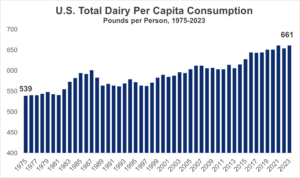A new year, a new administration, a new Congress, and new challenges. Regardless of what does or doesn’t happen this year, buckle up. And welcome to 2025.
The watchword of the year is change. Voters demanded it, and members of Congress and the new administration are vowing to deliver. At the same time, what those changes may be, how they occur, and which ones happen when, remain very open questions. Until new leaders in federal agencies are in place, and until congressional coalitions begin to coalesce, where dairy’s priorities fit into the broader picture remains to be seen – and as last month’s column stated, sorting out what’s real and what isn’t, and acting accordingly, is itself a critical area of emphasis in 2025.
But we do know this: We at NMPF are ready to pursue and seize the opportunities for better farm policy that will undoubtedly present themselves over the course of the next year. Here’s why:
- We’re coming off a great 2024. Our successful efforts at building what became the foundation of a USDA Federal Milk Marketing Order modernization plan that farmers can get behind; our efforts to maintain dairy’s prominence in the federal Dietary Guidelines for Americans as reflected in its recent scientific report; and our leadership in developing export markets through collaboration with the U.S. Dairy Export Council and others, all create the muscle memory and momentum that carries us into this year with credibility and confidence.
- We have a great team. In each of our key areas of emphasis – government relations and regulatory affairs, economics and trade – we have seasoned, well-connected staff working hard to understand the new policy environment and make it work for dairy farmers and their cooperatives. As Washington transitions, we are making the phone calls and meeting the key players as they emerge, ensuring our interests are on their minds.
- We speak with a consistent voice. As we saw throughout FMMO, the power of farmer unity is not to be underestimated. By representing the cooperatives that handle the vast majority of U.S. milk, we play key roles in nourishing Americans and the world while boosting rural economies. That’s our voice – and it’s a voice to be reckoned with that’s recognized in policy circles.
- We are supported by the collective strength of our members and the broader dairy industry. NMPF takes pride in being a leader, but we also know we are far from alone in our efforts. Our colleagues among cooperatives and our friends in the broader dairy and agricultural communities create momentum and quality teamwork as we seek our goals together. It’s like returning a kickoff in football – a team that has the ball, knows its assignments and makes the right blocks can make it a long way downfield. And we do, and we will.
That doesn’t mean we’ll always be on offense. When proposals come up that create problems for dairy farmers and their cooperatives, we will respond effectively on behalf of our members. Within the new Washington are many perspectives, and we will work to support the outcomes that best allow dairy to thrive. We are confident of positive change – we also know that much of it won’t come easily.
But above all, we’re ready. Ready to embark on a new path in an era that has its risks and pitfalls, but that also holds exciting opportunities. Let’s work together, and we’ll make good things happen for dairy.
Gregg Doud
President & CEO, NMPF


 By Paul Bleiberg, Executive Vice President, Government Affairs, National Milk Producers Federation
By Paul Bleiberg, Executive Vice President, Government Affairs, National Milk Producers Federation




